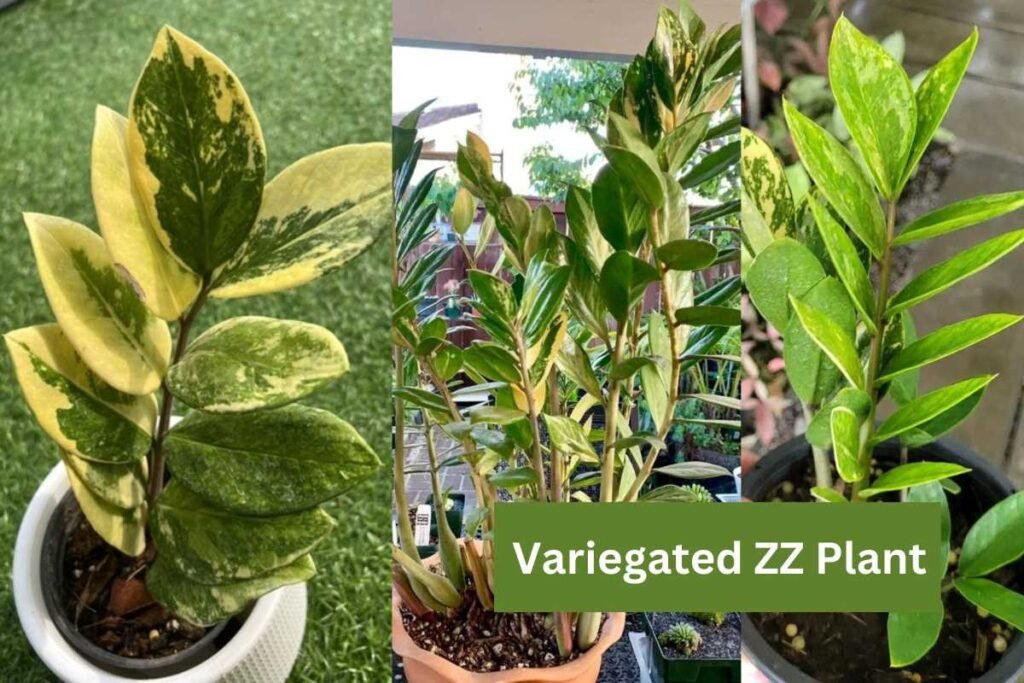The variegated ZZ plant is a beautiful and striking houseplant that has become increasingly popular in recent years.
With its lush, textured leaves and unique, two-tone color pattern, it offers a stunning look that can bring a touch of nature indoors.
And the best part is, this plant requires very little care or maintenance to look its best.
Description
The variegated ZZ plant (or Zamioculcas zamiifolia ‘Variegata’) is an evergreen perennial belonging to the Araceae family.
It has an upright stem with glossy green and cream-colored foliage, giving the effect of having two distinct colors in each leaf.
The leaves are thickly veined and clustered along stems that create an attractive texture throughout the entire plant.
In addition, variegated ZZ plants often produce small white flowers during the springtime months.

Advantages
There are many advantages to owning a variegated ZZ plant as a houseplant. First of all, they are incredibly low-maintenance plants and require little attention when properly cared for.
They do not need excessive amounts of water or light, preferring indirect sunlight and minimal fertilizing throughout the year.
Additionally, these plants can survive in almost any type of soil and make great additions to both indoor and outdoor gardens alike.
How to Grow
While variegated ZZ plants are generally easy to grow, there are still some important things you should know about caring for them properly:
- Light: These plants thrive in bright but indirect sunlight such as near windowsills or other areas that get lots of natural light without direct exposure from midday sun rays.
- Water: Water your plant thoroughly every few weeks when the soil begins to dry out; however, be sure not to overwater as too much humidity can cause issues with root rot or leaf drop.
- Soil: A well-draining potting mix will ensure your plant remains healthy; use either potting soil mixed with sand or peat moss for optimal results.
- Fertilizer: Fertilize your variegated ZZ plant once every month during its active growth season (spring through autumn) using a balanced liquid fertilizer diluted according to package instructions.
- Pruning: Prune away dead foliage on occasion using sharp scissors or garden shears; this will encourage new growth while keeping your plant healthy and looking its best!
Why Choose Variegated ZZ Plants?
As we’ve seen above, there are plenty of reasons why gardeners might choose the variegated ZZ plant: its attractive foliage coloration, low-maintenance requirements, and hardy nature make it an ideal choice for many gardeners looking for something beautiful yet easy to care for in their outdoor space.
Additionally, its striking foliage coloration provides high contrast when used alongside other plants in flowerbeds or borders; its unique spikey texture also adds an interesting dimension when combined with softer foliage varieties such as ferns or grasses.
Finally, because it remains evergreen year round it can provide much-needed structure in winter gardens where many other perennials would have gone dormant over the colder months of the year.
You can read also about how to make ZZ plant bushy & top 15 types of ZZ plants.
Conclusion
The variegated ZZ plant is one of the most popular houseplants around due to its striking looks and minimal maintenance requirements – making it ideal for even beginner gardeners looking for something beautiful yet easy-to-care-for!
With proper care, you’ll enjoy its vibrant colors year-round while appreciating the added bonus of lower utility costs due to its energy efficiency compared to traditional lighting sources like lamps or overhead lights!
So why not give this stunning houseplant a try today?
Variegated ZZ plant Related FAQs:
How often should I water my variegated ZZ plant?
Variegated ZZ plants prefer to dry out slightly between waterings. Water thoroughly when the top inch of soil feels dry, typically every two to three weeks. Ensure proper drainage to prevent waterlogging, which can lead to root rot.
What kind of light does a variegated ZZ plant need?
Variegated ZZ plants thrive in bright, indirect light. Place them near a window where they can receive plenty of natural light without direct exposure to harsh sun rays, especially during the midday hours.
How can I fertilize my variegated ZZ plant?
Fertilize your variegated ZZ plant once a month during its active growing season, which typically spans from spring to autumn. Use a balanced liquid fertilizer diluted according to the package instructions to avoid overfeeding.
Can I propagate my variegated ZZ plant?
Yes, variegated ZZ plants can be propagated through division or leaf cuttings. Division involves separating the plant into smaller sections with roots, while leaf cuttings can be taken from healthy stems and rooted in water or soil.
Is the variegated ZZ plant toxic to pets?
Yes, like its non-variegated counterpart, the variegated ZZ plant is toxic to pets if ingested. Keep it out of reach of curious pets or consider choosing pet-safe houseplants if you have animals at home.
How can I encourage bushy growth in my variegated ZZ plant?
Regular pruning can help promote bushy growth in variegated ZZ plants. Trim away dead or yellowing leaves with sharp scissors or shears to encourage new growth from the base of the plant.
What should I do if my variegated ZZ plant’s leaves are turning yellow?
Yellowing leaves on a variegated ZZ plant can be a sign of overwatering or underwatering. Check the soil moisture and adjust your watering routine accordingly. Ensure proper drainage and consider repotting if the soil is consistently waterlogged.
Can variegated ZZ plants tolerate low light conditions?
While variegated ZZ plants prefer bright, indirect light, they can tolerate low light conditions better than many other houseplants. However, their growth may slow down, and they may become leggy in low light environments.
Are variegated ZZ plants suitable for outdoor gardens?
Yes, variegated ZZ plants can thrive in outdoor gardens, particularly in shaded or partially shaded areas. Ensure they are protected from direct sunlight, as excessive exposure can scorch their leaves. They can be used as accent plants in flower beds, borders, or containers.
Do variegated ZZ plants require any special soil mix?
Variegated ZZ plants prefer well-draining soil to prevent waterlogging, which can lead to root rot. A mix of potting soil with sand or peat moss works well. Avoid heavy clay soils that retain too much moisture.
Can variegated ZZ plants tolerate fluctuations in temperature?
Variegated ZZ plants are relatively tolerant of temperature fluctuations, but they prefer consistent temperatures between 65°F to 75°F (18°C to 24°C). Avoid placing them near drafts or extreme temperature changes, such as vents or heaters.
How big do variegated ZZ plants grow?
Variegated ZZ plants typically grow to be about 2 to 3 feet tall, although they can vary depending on growing conditions and care. With proper care, they can develop a bushy appearance and fill out nicely.
Are variegated ZZ plants prone to pests or diseases?
Variegated ZZ plants are relatively resistant to pests and diseases, but they can occasionally attract mealybugs, spider mites, or scale insects. Regular inspection of leaves and stems can help detect any infestations early, and treatment with insecticidal soap or neem oil can help control pests.
Can variegated ZZ plants be grown in water?
While variegated ZZ plants can be propagated in water from leaf cuttings, they are not well-suited for long-term growth in water. They require a well-draining soil mix to thrive and should be potted in soil once roots have developed.
How do I revive a wilting variegated ZZ plant?
If your variegated ZZ plant is wilting, it may be a sign of overwatering or underwatering. Check the soil moisture and adjust your watering routine accordingly. Trim away any dead or yellowing leaves, and ensure proper drainage to prevent further issues. If the plant continues to decline, consider repotting in fresh soil.
Can variegated ZZ plants tolerate humidity?
Variegated ZZ plants are adaptable to a range of humidity levels and can tolerate moderate humidity. However, they prefer average indoor humidity levels and may suffer from issues like fungal diseases if exposed to excessively high humidity for prolonged periods.
Are variegated ZZ plants suitable for offices or indoor spaces with limited natural light?
Yes, variegated ZZ plants are excellent choices for offices or indoor spaces with limited natural light. They can thrive in low-light conditions better than many other houseplants, making them ideal for environments with fluorescent lighting or minimal windows.
Do variegated ZZ plants need to be repotted often?
Variegated ZZ plants are slow growers and can tolerate being slightly pot-bound. Repotting is typically only necessary when the plant has outgrown its current container or when the soil has become compacted and does not drain well. Repotting every two to three years may be sufficient.
Can variegated ZZ plants be grown outdoors in colder climates?
Variegated ZZ plants are sensitive to frost and cold temperatures and are best suited for outdoor cultivation in USDA hardiness zones 9 to 11. In colder climates, they are often grown as indoor plants or in containers that can be moved indoors during the winter months.
How do I prevent pests and diseases in my variegated ZZ plant?
To prevent pests and diseases in variegated ZZ plants, practice good hygiene by keeping the plant and its surroundings clean. Avoid overwatering, which can lead to fungal issues, and ensure proper air circulation around the plant. Inspect the leaves regularly for signs of pests or diseases, and treat any issues promptly with appropriate remedies.
Can variegated ZZ plants be pruned heavily?
Variegated ZZ plants can tolerate moderate pruning to remove dead or damaged foliage and encourage bushier growth. However, avoid heavy pruning that removes large portions of the plant, as this can stress the plant and inhibit its growth. Prune selectively to maintain the plant’s shape and health.
Are variegated ZZ plants suitable for beginners?
Yes, variegated ZZ plants are excellent choices for beginner gardeners due to their low-maintenance nature and tolerance for a wide range of growing conditions. With minimal care requirements, they are forgiving plants that can thrive even with occasional neglect.


Chasing the variegated black zz. Any ideas Shahriar, please email me!?